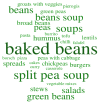Towards More Sustainable Diets-Attitudes, Opportunities and Barriers to Fostering Pulse Consumption in Polish Cities
- PMID: 32485812
- PMCID: PMC7352634
- DOI: 10.3390/nu12061589
Towards More Sustainable Diets-Attitudes, Opportunities and Barriers to Fostering Pulse Consumption in Polish Cities
Abstract
Despite the evidence-based health benefits of pulses and their significant role in sustainable diets, consumption remains at a very low level in highly developed countries. In an attempt to fill in the knowledge gaps on factors influencing this phenomenon, a study aimed at identifying attitudes, incentives and barriers to pulse consumption was carried out in a sample of 1027 Polish urban employees aged 25-40 years. The sample (quota type) was representative in terms of age and gender. Exploratory classifications using Kohonen neural networks were performed to define profiles of participants for each analysed issue. Pearson's chi-square analysis was used to check whether the profiles depended on socio-demographic characteristics of the respondents. The results suggest that very low pulse consumption is a result of lack of habits, discomfort after eating and long preparation time. Pulses were recognized as a good source of protein (72% of the sample), especially among women (81%). Only 43% of the sample saw pulses as a substitute for meat. The majority of consumers pictured pulses as a tasty and healthy food, although they were not sure if this is true for small children. Women recognised pulses as a more environmentally friendly food but this knowledge would not impact their intake. Profiles of respondents with positive attitudes towards increased pulse consumption were identified, constituting 39% of the sample. These consumers could eat more if they were encouraged to do so. This shows that programmes aimed at fostering greater pulse consumption are crucial to activate a change towards more sustainable diets. At the same time, simple and clear guidelines should be developed to overcome the unjustified stereotypes about pulses. These would support consumers to make healthier and more sustainable choices and help professionals carry out effective promotion and education activities.
Keywords: Poland; beans; cities; consumption; employees; plant protein; pulses; sustainable diets.
Conflict of interest statement
The authors declare no conflict of interest. The funders had no role in the design of the study; in the collection, analyses, or interpretation of data; in the writing of the manuscript, or in the decision to publish the results.
Figures




References
-
- FAO . Pulses: Nutritions Seeds for Sustainable Future. FAO; Rome, Italy: 2016. pp. 1–196.
-
- Górnicka M., Pierzynowska J., Wiśniewska M., Frąckiewicz J. An analysis of the consumption of dry leguminous vegetable seeds in Poland in 1999-2008 (in Polish with English summary) Bromatol. Chem. Toksykol. 2011;4:1034–1038.
-
- Margier M., Georgé S., Hafnaoui N., Remond D., Nowicki M., Du Chaffaut L., Amiot M.J., Reboul E. Nutritional composition and bioactive content of legumes: Characterization of pulses frequently consumed in France and effect of the cooking method. Nutrients. 2018;10:1668. doi: 10.3390/nu10111668. - DOI - PMC - PubMed
-
- Iqbal A., Khalil I.A., Ateeq N., Sayyar Khan M. Nutritional quality of important food legumes. Food Chem. 2006;97:331–335. doi: 10.1016/j.foodchem.2005.05.011. - DOI
MeSH terms
Substances
Grants and funding
LinkOut - more resources
Full Text Sources
Other Literature Sources
Medical

